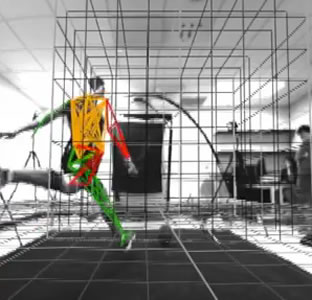UTSA researchers develop prototype football kicking simulator

UTSA Football Kicking Simulator
>> Watch a video about the simulator.

UTSA Football Kicking Simulator
>> Watch a video about the simulator.
(Oct. 30, 2013) -- In football, kicking is a fundamental and vital part of the game. The few points a kicker scores can make a critical difference in the outcome of a game. To help improve a football kicker's performance, University of Texas at San Antonio (UTSA) mechanical and bioengineering professor Yusheng Feng and seven students have developed the prototype components for a football kicking simulator designed to be a real-time training tool.
Sponsored by the UTSA Center for Simulation, Visualization and Real-Time Prediction (SiViRT) with funding from the National Science Foundation (NSF), the Football Kicking Simulation and Human Performance Assessment is a virtual training system that uses real-time wireless feedback and computer sensing to measure football kicking mechanics data.
It gives a kicker the ability to practice either on or off the field and receive the same kind of attention to detail he would experience at a training camp. Moreover, the quantitative data collected from the football dynamics and kicker's body motion can not only be used to predict the accuracy of a kick, but also give feedback to maximize the kicking power while mitigating the risk of injury.
In particular, the prototype provides quantifiable measures to improve a football kicker's consistency and reliability by:
- Predicting the football's trajectory, incorporating real life factors such as drag, lift and wind factor
- Sensing the pressure of the planted foot and angle of contact
- Capturing the body motion of legs and joints through high-speed cameras and video tracking
- Displaying a realistic stadium environment by providing 3D visualization and surrounding sound
- Providing dynamic and kinesiological analyses and simulations for coaches and players to design player-specific training programs
UTSA mechanical engineering undergraduate students Alyssa Schaefbauer, Cole Meyers, Jacob Kantor and Michael Lasch, kinesiology undergraduate student Ekow Acquaah, along with electrical and computer engineering graduate student Aaron Stout and computer science graduate student Ehren Biglari, have been developing and testing the virtual training system under the mentorship of Feng since February 2012.
"What sets our product apart from other kicking simulations is that we are using computer sensing and mathematical models to predict the football trajectory along with various training tools. It was designed specifically to be used for training rather than a form of entertainment, and it will be affordable," said Schaefbauer, the student team leader.
The group has been working with UTSA football place-kicker Sean Ianno and assistant coach Perry Eliano to test the simulator and make necessary adjustments for ideal training. In order to consider the human factors in training and coaching, they also are incorporating feedback from faculty members in the UTSA Department of Health and Kinesiology.
"The simulator is an awesome idea. Although it is not a finished product yet, it has the potential to be on the cutting edge of technology and quite possibly could revolutionize how kickers train," said Ianno.
"The kicking simulator is an incredible project and something I believe can be very beneficial not only for our kickers, but for kickers across the country," Eliano said. "I'm really humbled and thankful that the College of Engineering and their students who worked their tails off on this project chose us to be a part of it."
The research team has published two papers that were presented at the International Workshop on Computer Science in Sports and the Society for Modeling and Simulation International conference this summer.
"The football kicking simulator is a perfect example of how engineering and science can make improvements beyond the scientific arena, such as football, that are of interest to the greater community," said Feng. "It has been exciting to see these students develop into fine researchers who are determined to make a difference in society."
The research team has filed a patent application for the technology through the UTSA Office of Commercialization and Innovation and the team hopes to make the simulator commercially available for coaches and football teams to use as a training tool.
Established in August 2009 as a result of a $5 million grant from the National Science Foundation (NSF), the UTSA Center for Simulation, Visualization and Real-Time Prediction is a computation and visualization center that integrates high-performance computing into its activities, which include imaging, visualization, modeling and simulation to help faculty and student researchers investigate structural reliability, particle flow, nanotechnology, biomechanics, computational neuroscience and cancer treatment simulation.
The SiViRT Center aims to shape UTSA's research environment by creating and supporting first-hand collaborative research and design experiences for both undergraduate and graduate students year-round. It is an interdisciplinary research center where students can apply their knowledge through teamwork.
For more information regarding the licensing of this or any UTSA technology, email the UTSA Office of Commercialization and Innovation at oci@utsa.edu or call 210-458-6963.
Events
The UTSA Office of Undergraduate is proud to celebrate National Undergraduate Research with an annual event sponsored by the (OUR) featuring students will showcase undergraduate student research and creative endeavors from all disciplines across campus.
Various LocationsDía en la Sombrilla, formerly Fiesta UTSA, is a festival hosted each spring as a part of Fiesta® San Antonio events. Sponsored by Roadrunner Productions, the event features music, food, confetti, games, event t-shirts, and more.
Sombrilla Plaza and Central Plaza, Main CampusFiesta Arts Fair features contemporary art from more than 100 artists from across the U.S., Fiesta favorite foods, drinks, live music by local and regional performers, and a Young Artists Garden providing opportunities for budding artists to learn, explore and express their creativity.
UTSA Southwest CampusJoin the PEACE Center and Wellbeing Services for Denim Day, a day of learning about the importance of consent and why we wear denim on the last Wednesday of the month each April during Sexual Assault Awareness Month. Stop by our Denim Day display to take a photo in front of our Denim Wall, spin the "Is It Consent?" Wheel, and get a Concha or goodie.
Student Union Window Lounge, Main CampusLearn to use Zotero®, a citation manager that can help you store and organize citations you find during your research. Zotero can generate bibliographies in various styles, insert in-text citations and allow you to share sources with collaborators.
Virtual EventCelebrate the accomplishments of College of Education and Human Development, College for Health, Community and Policy, College of Sciences and University College.
AlamodomeCelebrate the accomplishments of Alvarez College of Business, College of Liberal and Fine Arts and Klesse College of Engineering and Integrated Design.
Alamodome

